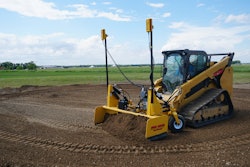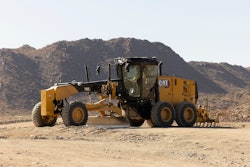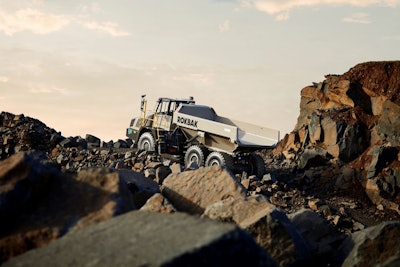
Articulated dump trucks continue to advance technologically, as manufacturers develop new ways to make life easier and more productive for operators in these days of debilitating labor shortages.
Artics now come equipped with such features as pedestrian detection, automatic systems to increase traction and to reduce speed on hill descents, and assisted hoist for reducing some of the repetitive motions of dumping.
Telematics are delivering real-time data to help improve productivity. Some OEMs are also increasing service intervals for time and cost savings.
Here’s a look at what’s new and improved with artics.
Autonomy: ‘not merely a concept’
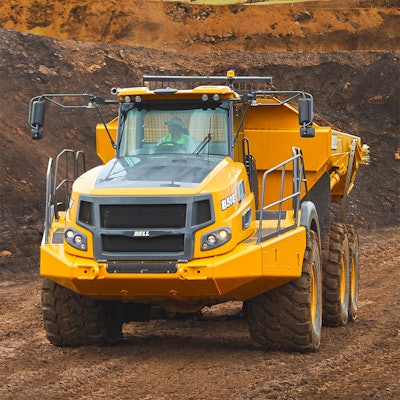 The Bell 50E has a Mercedes-Benz engine rated at 543 net horsepower. The seven-speed transmission is an Allison 4800 ORS. Tires are 875/65 R29, which Bell says is a completely new design with a higher capacity, “making the B50E the first true 50-ton truck.” Optional are 29.5 R25 tires. Struck capacity at 2:1 is 36 cubic yards.Bell Equipment
The Bell 50E has a Mercedes-Benz engine rated at 543 net horsepower. The seven-speed transmission is an Allison 4800 ORS. Tires are 875/65 R29, which Bell says is a completely new design with a higher capacity, “making the B50E the first true 50-ton truck.” Optional are 29.5 R25 tires. Struck capacity at 2:1 is 36 cubic yards.Bell Equipment
“We’re part of a green revolution but we’ve found ways to serve both the environment and the customer at the same time,” he says.
All Bell trucks run on Mercedes-Benz engines and Allison transmissions to maximize production efficiency while also adding the convenience and cost-effectiveness of commonality to their line.
Similarly, the company uses providers for its autonomous systems rather than develop its own.
In North America, it uses Pronto AI. The pedestrian detection system is also outsourced. The key to integrating these systems is sophisticated and adaptable electronics.
“To demonstrate the power and flexibility of the circuitry on our trucks,” says Kyriacos, “we operated a truck with an Xbox controller at distances of up to 20 meters.”
The same sophisticated technology is what makes “autonomous operation a fact, not merely a concept,” says Robin Pett, product manager. “We have sites in the U.S. where all the machines are communicating with each other. Even a pickup that drives onto the site has a communication beacon.”
Autonomous operation improves efficiency, says Kyriacos. “Suppose the site design and loading tool dictate that 3.2 trucks is the optimal number of trucks to have. With three trucks, the loader operator sits idle at times. With four trucks, the truck operators sit idle. Autonomous operation manages truck speed and other factors to eliminate unnecessary idling by anyone, to save fuel and wear and maximize productivity.”
Payload monitoring has been standard on Bell trucks since 2002. The system now includes inclinometers to compensate for the pitch of the truck while loading because pitch can alter the pressure on payload sensors.
The inclinometers also help with hill assist and hill hold. With hill hold, for example, the system knows the pitch and the load and determines the torque required to create movement under those conditions. The system will not release the service brakes until sufficient torque is provided to the wheels, which virtually eliminates rollback.
Removing the drudgery
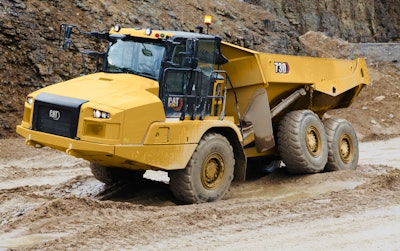 The Cat 730 has a payload of 31 tons and a capacity of 23 cubic yards in a 2:1 heap. A Cat C13 engine rated at 370 net horsepower requires no de-rating to 12,500 feet. The transmission has six forward and one reverse gear. The spacious cab has a sound level of just 72dB(A), while the combined hoist and transmission lever cuts operator input in half.Caterpillar
The Cat 730 has a payload of 31 tons and a capacity of 23 cubic yards in a 2:1 heap. A Cat C13 engine rated at 370 net horsepower requires no de-rating to 12,500 feet. The transmission has six forward and one reverse gear. The spacious cab has a sound level of just 72dB(A), while the combined hoist and transmission lever cuts operator input in half.Caterpillar
Automatic Retarding Control is fully automatic. Sensors tell the system if the truck is going downhill, the gear position, speed and whether the truck is loaded.
When the operator’s foot comes off the accelerator on a descent, the system engages ARC at the level dictated by conditions. If more slowing power is needed, ARC will apply the service brakes and, if needed, execute a downshift while still protecting the engine from overspeeding.
Stability assist sounds a continuous alarm if the side slope exceeds 15%. The percent of grade needed to trigger the alarm can be set by the operator. It will also inhibit hoist actuation under these conditions. Stability assist is on all models from 725 through 745, including GC models.
“The most popular feature among drivers is assisted hoist,” says Scott Thomas, Cat production application specialist, “which automates the dump cycle.”
If the truck is stopped or traveling less than 2 mph and the driver engages assisted hoist by the feature’s fingertip control, the truck will automatically shift to neutral, apply the service brakes and raise the bed. Assisted hoist is available with the gear selector in any position.
“Assisted hoist takes the drudgery out of a repetitive operation,” says Thomas.
Real-time productivity monitoring
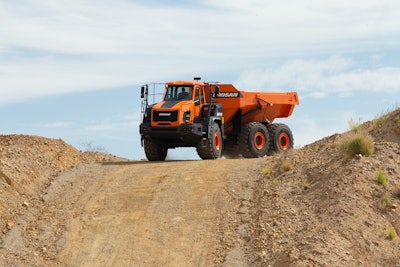 The rated payload of the Doosan DA45-5 is 90,390 pounds, and the body volume is 31.9 cubic yards. Net horsepower is 483, and the transmission has eight forward and four reverse speeds. Overall width is under 12 feet for easier transport. The cab features fully automatic climate control, air suspension seating, excellent visibility and low noise levels.Doosan
The rated payload of the Doosan DA45-5 is 90,390 pounds, and the body volume is 31.9 cubic yards. Net horsepower is 483, and the transmission has eight forward and four reverse speeds. Overall width is under 12 feet for easier transport. The cab features fully automatic climate control, air suspension seating, excellent visibility and low noise levels.Doosan
The free-swinging tandem rear bogie remains in use. The design yields better tracking in extreme terrain and, with a single-drive axle, has fewer moving parts than other designs. Tractive force is so good that drivers can back farther up a pile before dumping, “in some cases eliminating the need for a dozer to build the pile,” says Aaron Kleingartner, dealer and product marketing manager, Doosan Infracore North America.
Limited-slip differentials and a lockable interaxle differential further improve traction. The hydraulic retarder engages automatically and can be set by the operator in 25% increments.
Kleingartner says the use of telematics, such as DoosanConnect, has matured. Once relied upon for simple tasks such as geofencing and recording fuel use, telematics are now used in real-time to monitor and improve productivity.
And electronic trucks?
“We continue to advance in that direction as motor and battery designs improve,” says Kleingartner. Doosan also continues to develop its Concept-X platform of the autonomous jobsite.
Payload meter now standard
 Capacity of the Komatsu HM400-5 is 44.1 tons. Power comes from a Komatsu SAA6D-140E-7 engine rated at 466 net horsepower and 1,669 pound-feet of torque. The fully automatic, countershaft transmission has six forward and two reverse speeds. Torque converter drive is used in first gear; first-gear lockup and all other gears use direct drive.Komatsu
Capacity of the Komatsu HM400-5 is 44.1 tons. Power comes from a Komatsu SAA6D-140E-7 engine rated at 466 net horsepower and 1,669 pound-feet of torque. The fully automatic, countershaft transmission has six forward and two reverse speeds. Torque converter drive is used in first gear; first-gear lockup and all other gears use direct drive.Komatsu
First of the new features is a common dump body. In the past, customers had to specify whether they wanted a heated or non-heated body setup. Now all Komatsu articulated truck bodies come with exhaust heat channels installed from the factory. The customer still specs the desired body setup when ordering, but bodies can be converted at any time with an exhaust reroute kit. This is especially valuable for customers who move into colder markets with their existing trucks; it also increases residual value in the secondary market.
The second new feature is the Automatic Retarder Accelerator Control. All slowing is done using the service brakes; there is no engine brake or transmission retarder.
ARAC engages at 4.3 mph on descents when the operator’s foot comes off the accelerator. Oil flow is increased to the brakes when ARAC is activated.
Before ARAC, the operator maintained speed using a manual retarder lever; that lever is still in place and allows the operator to increase slowing effort above what is provided by ARAC when needed.
The first of the two existing features Hussey wants to emphasize is the Komatsu payload meter. It was optional on previous models and is now standard on Dash-5 trucks.
“The system is more advanced than it is generally given credit for,” says Hussey. “It provides a lot of data to a lot of people seamlessly, simultaneously.” Information is provided via the in-cab monitor, indicator lamps mounted on the truck, and Komtrax telematics to the truck operator, the loader operator and management, respectively.
The load lights are green, yellow and red but can also be off, flashing or steady. The optimal load is when the green and yellow lights are steady on, and the red light is flashing.
The payload meter system controls the lights based on the effects on payload of previous passes from the loader in the current loading cycle. The system resets at the dump cycle. Payload information is transmitted after the truck has traveled 525 feet, to provide more accurate data; that standard is user-settable for sites with shorter haul distances.
Hussey also calls attention to the Komatsu Traction Control System, which uses the service brakes for controlling wheel slip. This reduces tire wear compared to locking differentials. There is a locking interaxle differential that can be set to engage automatically or manually as conditions require.
New name, long history
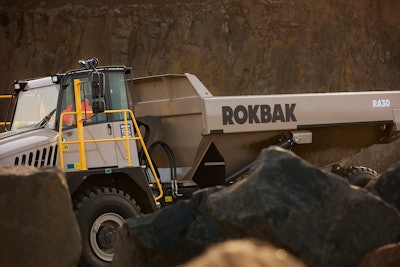 There are two models in the Rokbak line. The RA30 has a maximum payload of 30.9 tons, a heaped capacity of 22.9 cubic yards and an engine rated at 370 horsepower. Specs for the RA40 are 41.9 tons, 30.3 cubic yards and 444 horsepower. Comfort features include a high-back seat with adjustable air suspension and adjustable armrests, premium HVAC with optimal airflow and clear instrumentation and LCD display.Rokbak
There are two models in the Rokbak line. The RA30 has a maximum payload of 30.9 tons, a heaped capacity of 22.9 cubic yards and an engine rated at 370 horsepower. Specs for the RA40 are 41.9 tons, 30.3 cubic yards and 444 horsepower. Comfort features include a high-back seat with adjustable air suspension and adjustable armrests, premium HVAC with optimal airflow and clear instrumentation and LCD display.Rokbak
Why?
“Managing brand names is common at Volvo,” says Scott Pollack, senior product manager, Rokbak. “We wanted a unique name while at the same time carrying forward the long history of technology and innovation established by the Terex Trucks brand.”
Examples of features carried forward include the hydraulic tilt cab and electric tilt hood.
With Rokbak models, PM intervals are longer – up to 4,000 hours on the RA30 and up to 6,000 hours on the RA40 for transmission fluid and filter changes. This and the use of semi-synthetic transmission fluid reduces transmission costs by up to one-third.
The standard Rokbak warranty in North America is three years, 3,000 hours, and three years, 6,000 hours on the powertrain. A maintenance plan and Haul Track telematics subscription are available on registration; each is for three years or 3,000 hours.
Comfort features on Rokbak trucks include a semi-pressurized cab, improved HVAC with better temperature control, and an air-ride seat with three user-settable suspension rates.
Other features include on-board weighing as part of the optional Haul Track telematics package and inclinometers on the dump body to help prevent tip-over.
Cutting time, money on preventive maintenance
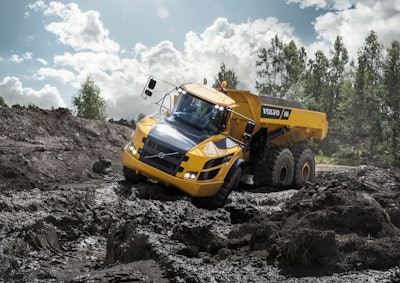 Payload capacity for the Volvo A40G is 43 tons. Body volume at a 2:1 heap is 31.4 cubic yards. The Volvo D13J engine is rated at 469 gross horsepower and 1,862 pound-feet of torque. Volvo Dynamic Drive and predictive gear selection adapt to operating conditions for improved comfort and fuel efficiency. It also features cruise control, hill assist, hill hold and OptiShift.Volvo CE
Payload capacity for the Volvo A40G is 43 tons. Body volume at a 2:1 heap is 31.4 cubic yards. The Volvo D13J engine is rated at 469 gross horsepower and 1,862 pound-feet of torque. Volvo Dynamic Drive and predictive gear selection adapt to operating conditions for improved comfort and fuel efficiency. It also features cruise control, hill assist, hill hold and OptiShift.Volvo CE
A new quick-fit system enables cleaner, faster oil changes. New handles on both sides of the counterweight make service points easier to access. Improvements to PM practices will cut maintenance costs and scheduled downtime up to half without compromising component performance or longevity, the company says.
A tire pressure monitoring system is now standard on Volvo A35G, A40G, A45G, A45GFS and A60H haulers; it is optional on the A25G and A30G. Tire information is shown on the Volvo Co-Pilot in-cab tablet display.
TPMS is a good tool, but proper tire management starts with tire selection, says Eric Fatyol, product manager, articulated haulers, Volvo Construction Equipment. “You’ll typically replace all six tires at one time, and selecting the right size for your application is important, especially when it comes to standard versus high-flotation tires.”
He says the standard tires are fine for most applications; high-flotation tires are preferred in softer conditions, such as wet mud or clay. On an A40G or A45G, the standard tire would be a 29.5R25 and a high-flotation tire would be an 875/65R29.
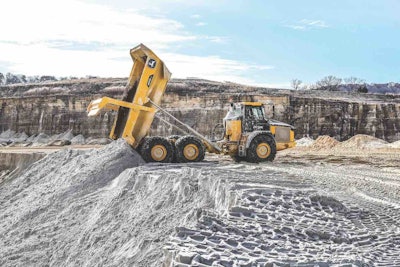 The 410E-II and 460E-II (shown above) models from John Deere represent an evolution of the E Series. Fuel consumption has dropped as much as 7%. The redesigned dump body is wider and has a lowered and leveled rail height for better material retention. Controls are simplified; a single sealed switch model reduces the number of switches by 25%, and an automotive-style multifunction turn-signal stalk has controls for the lights and windshield wipers.John Deere
The 410E-II and 460E-II (shown above) models from John Deere represent an evolution of the E Series. Fuel consumption has dropped as much as 7%. The redesigned dump body is wider and has a lowered and leveled rail height for better material retention. Controls are simplified; a single sealed switch model reduces the number of switches by 25%, and an automotive-style multifunction turn-signal stalk has controls for the lights and windshield wipers.John Deere

